by Craig Brelsford
Founder, shanghaibirding.com
INTRODUCTION
I spent 27 nights on Hainan Island, arriving in Sānyà on 14 Jan. and leaving on 10 Feb. My goal was to create a photographic survey of the birds of Hainan. I saw or heard 94 species, about a quarter of the total recorded for the island. Three of the species I noted are endemic to Hainan, and 23 are subspecies endemic to Hainan. I spent most of my time at Jiānfēnglǐng National Forest Park.
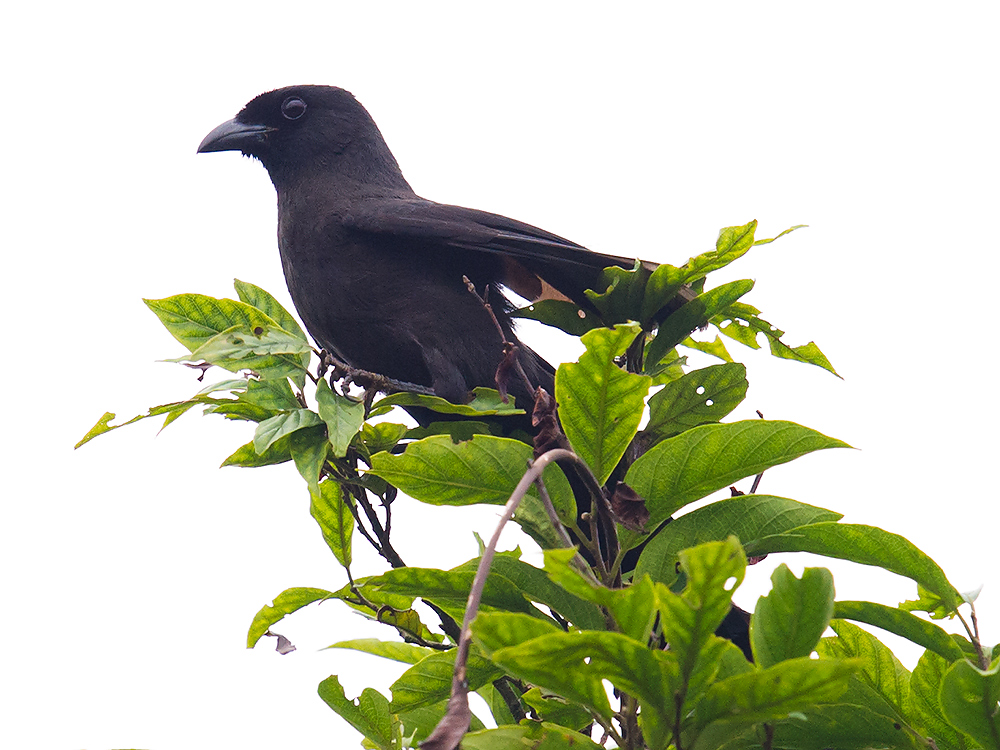
HIGHLIGHTS
• At Jiānfēnglǐng, photographing Ratchet-tailed Treepie, a species in China found only on Hainan
• Seeing, but never photographing, Hainan Peacock-Pheasant; hearing, but never seeing, Hainan Partridge. Both are endemic to Hainan
• At Bàwánglǐng, finding and photographing Hainan Silver Pheasant by driving slowly at dawn and dusk along the mountain roads
• Discovering a flowering tree next to a rooftop at Jiānfēnglǐng and from the vantage point atop the roof observing and photographing many species of bird
• Watching Greater Racket-tailed Drongo wait patiently for a Greater Yellownape to finish drilling. If the yellownape had prey, then the drongo would attempt to snatch it
• Finding Grey-headed Swamphen and Lesser Whistling Duck at Hǎiwěi Wetland
• At Jiānfēnglǐng, enjoying the cool nights and warm days at elev. 950 m (3,120 ft.)
THE TRIP (all dates 2013)
Mon. 14 Jan.
Shanghai, Sānyà (三亚), Jiānfēnglǐng (尖峰岭)
At 05:00 my assistant, Shàng Qún Yīng (尚群英), arrived at my apartment in Shanghai. Our flight for Sānyà (三亚) took off from Hóngqiáo Airport at 07:10. At Sānyà Airport, I rented a Nissan Tiida. I drove west, my destination Jiānfēnglǐng National Forest Park (尖峰岭国家森林公园, Jiānfēnglǐng Guójiā Sēnlín Gōngyuán). Near the entrance to the preserve (at an elev. of about 125 m or 410 ft.), I photographed a female Brown Shrike Lanius cristatus. At the gate, I found Asian Brown Flycatcher Muscicapa latirostris latirostris and Oriental Magpie-Robin Copsychus saularis prosthopellus. In the park I stopped at a parking area at elev. 750 m (2,460 ft.). A bird wave was passing through. Within it were a male and female White-browed Shrike-babbler Pteruthius aeralatus ricketti, White-throated Fantail Rhipidura albicollis celsa, Puff-throated Bulbul Alophoixus pallidus pallidus (endemic ssp.), and Grey-capped Pygmy Woodpecker Dendrocopos canicapillus swinhoei (endemic ssp.). On a branch 31 m away, just visible through a break in the trees, was a Collared Owlet Glaucidium brodiei brodiei. I was able to photograph both the face and the false face on the nape. Driving again, I found Grey Wagtail Motacilla cinerea and White-crowned Forktail Enicurus leschenaulti sinensis. White-crowned Forktail is the only species of forktail on Hainan. We arrived at the resort, elevation 950 m (3,120 ft.). In the parking lot, I found some very tame Puff-throated Bulbul and Mountain Bulbul Ixos mcclellandii holtii. In the forest, taking a short walk on the 2-km loop trail, I heard the clear, unmistakable calls of Hainan Partridge Arborophila ardens (endemic sp.). The birds, which judging by their calls were in two groups, were within a few hundred meters of me. I noted the loud, two-note, cuckoo-like call. After night fell, I heard the metallic, two-note whistle of Mountain Scops Owl Otus spilocephalus latouchi.
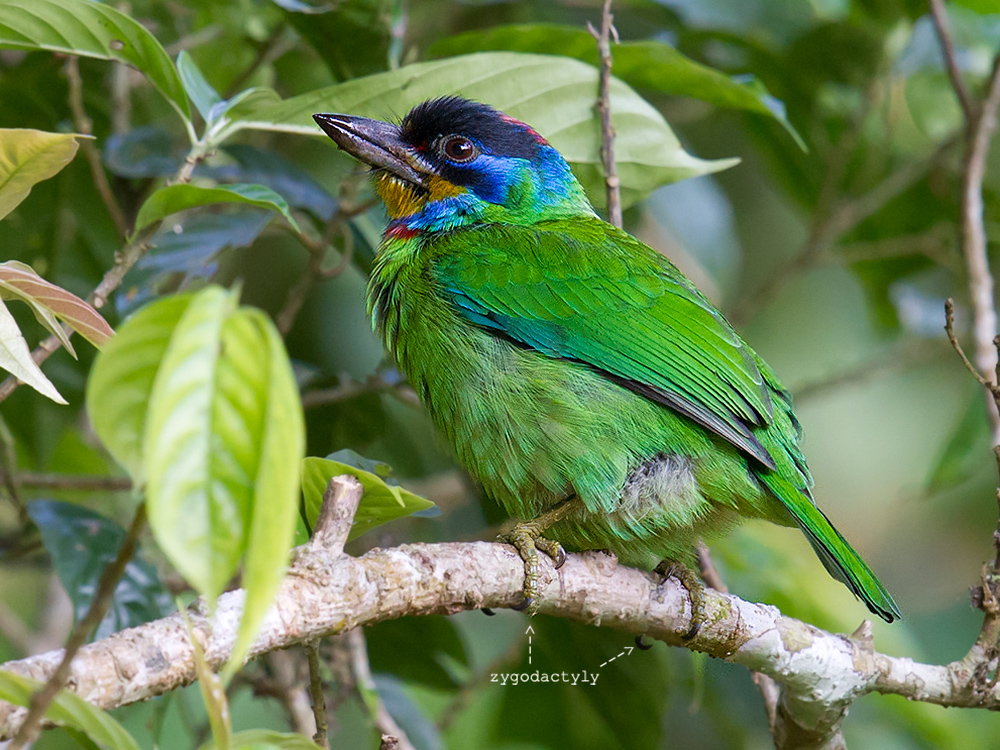
Tues. 15 Jan.
Jiānfēnglǐng
On the loop trail I photographed female Pale Blue Flycatcher Cyornis unicolor diaoluoensis (endemic ssp.). At Kōngzhōng Huāyuán (空中花园), a scenic spot on the loop trail, I found 2 Hainan Silver Pheasant Lophura nycthemera whiteheadi (endemic ssp. of Silver Pheasant). I admired the view of Mt. Jiānfēng, elev. 1400 m (4,590 ft.). Chinese Barbet Megalaima faber faber (endemic ssp.) were feeding in fruiting trees. Joining them were Mountain Bulbul, Puff-throated Bulbul, and Chestnut Bulbul Hemixos castanonotus castanonotus. Just down the trail from the deck at the scenic area, I found a female Red-headed Trogon Harpactes erythrocephalus hainanus (endemic ssp.). I saw a flock of Grey-headed Parrotbill Psittiparus gularis hainanus (endemic ssp.). After lunch, a bird wave passed through the resort. Within the wave was Yellow-billed Nuthatch Sitta solangiae chienfengensis (endemic ssp.). I found Grey-capped Pygmy Woodpecker and Olive-backed Pipit Anthus hodgsoni. Asian Palm Swift Cypsiurus balasiensis infumatus were flying noisily around the parking lot. They are a daily presence here.
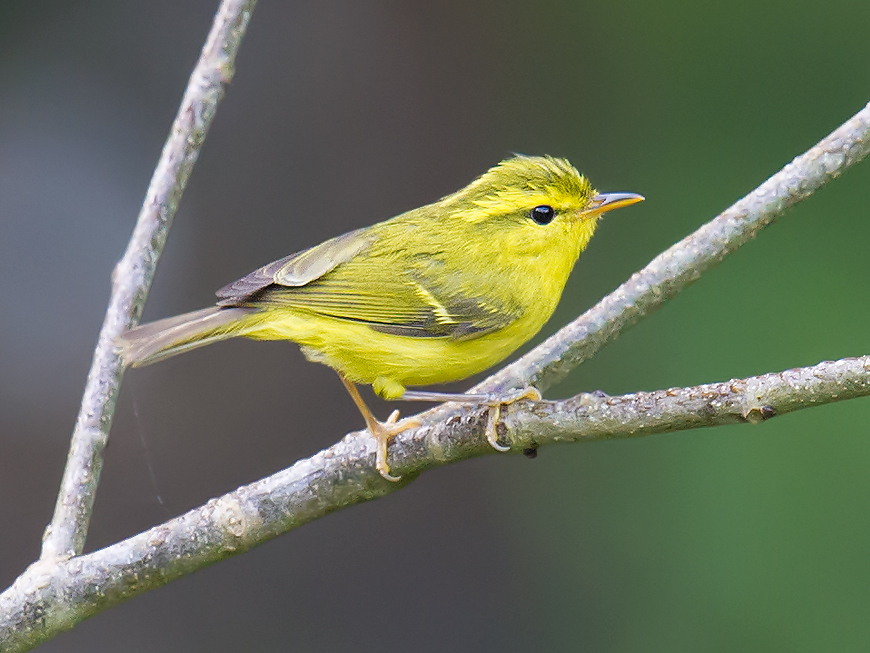
Wed. 16 Jan.
Jiānfēnglǐng
As soon as it was light, I walked slowly on the loop trail to Kōngzhōng Huāyuán. I glimpsed Hainan Silver Pheasant again. I had a brief encounter with White-bellied Erpornis Erpornis zantholeuca griseiloris. Until recently mistakenly considered to be a yuhina, White-bellied Erpornis is now properly assigned to Vireonidae and is one of the few representatives of the vireo family outside the Americas. Chinese Barbet and the three species of bulbul were feeding. I saw one of the better-known Hainan endemics: Hainan Leaf Warbler Phylloscopus hainanus. The warbler was making its loud call and working its way through a tree near me. I got my first images ever of Grey-chinned Minivet Pericrocotus solaris griseogularis. Of the four species of minivets in China whose males are scarlet, Grey-chinned is the easiest to distinguish. I was struck by the flycatcher-like smallness of the bird; it is noticeably smaller than the other three similarly colored minivets.
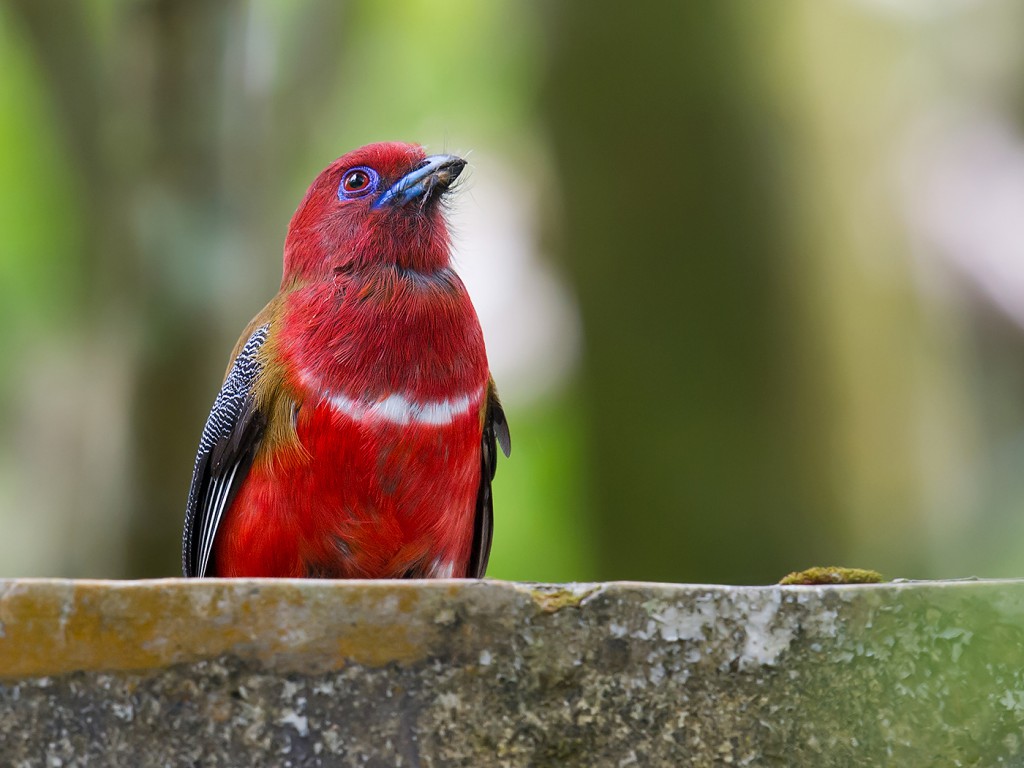
In the afternoon, at the resort, I got my first images of male Red-headed Trogon. I watched this unusual bird for several minutes. This non-passerine flycatcher (and fruit eater) is most unlike a Muscicapid flycatcher. It rests on its branch for minutes at a time, whereas a Muscicapid flycatcher usually waits only seconds before darting after prey. Compared to the Muscicapids, the trogon gives the impression of being an older model, an Edsel compared to a Corvette. To be sure, Red-headed Trogon is a “modern” bird, inasmuch as it and its relatives in Trogonidae are with us today; but the trogon family is an ancient one, as its pan-tropical distribution suggests. The trogon looks like no other bird in the forest. Like barbets and woodpeckers, it is a zygodactyl cavity nester, but it is otherwise quite unlike them. It chirrs softly, like a motor, and it screeches suddenly.
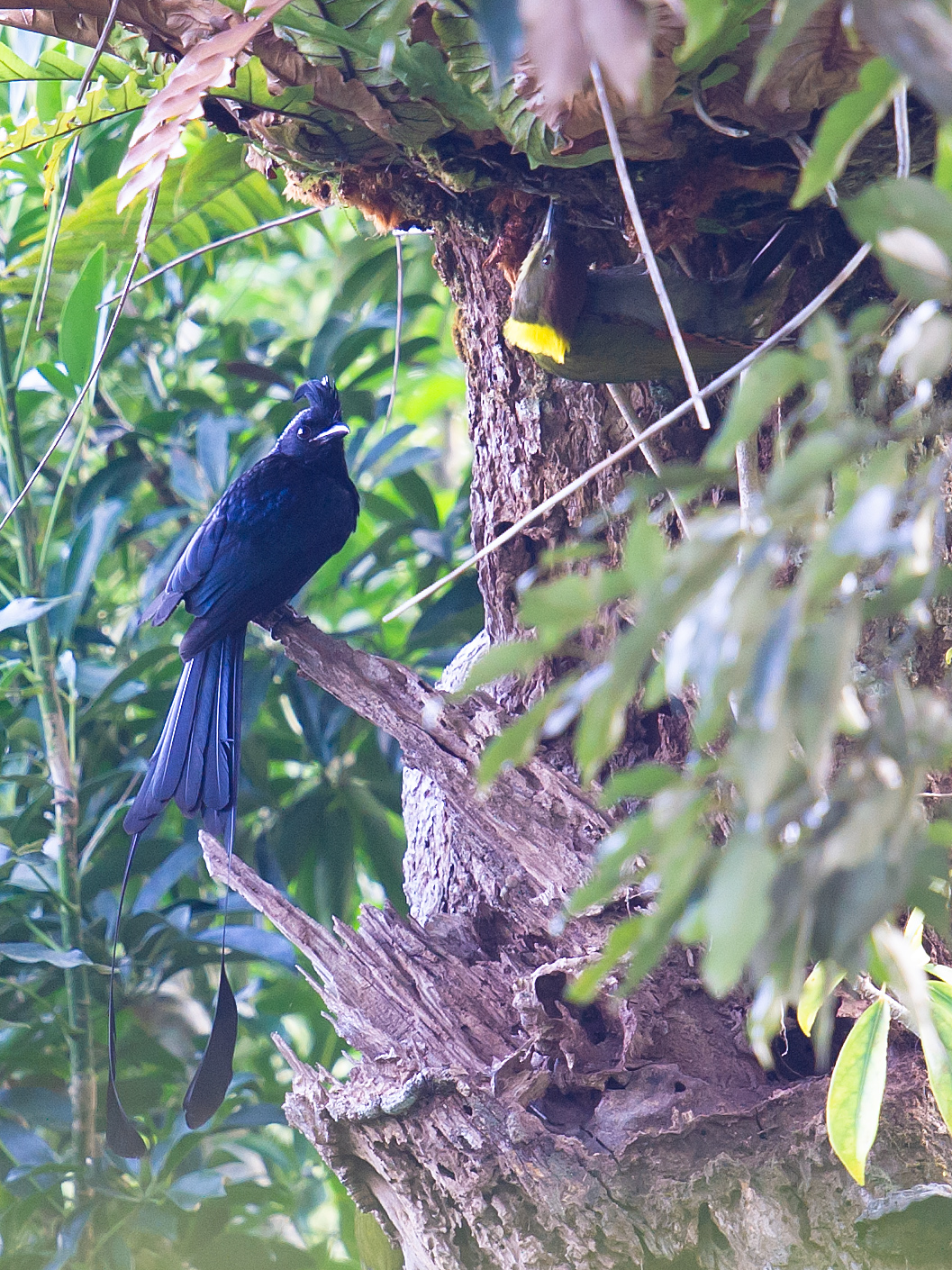
Standing on the roof of one of the chalets, I witnessed an interesting bit of behavior by a Greater Racket-tailed Drongo Dicrurus paradiseus johni (endemic ssp.) The drongo was perched beside Greater Yellownape Chrysophlegma flavinucha styani. The yellownape was drilling. As soon as it dug out something, the drongo reached in and tried to snatch it. Does not such behavior indicate that the drongo could envision a future event? The drongo must have learned that a drilling woodpecker is likely to dig out something worth stealing. I see training there, learning, not mere instinct.
Thurs. 17 Jan.
Jiānfēnglǐng
Another morning spent along the loop trail. The highlight of the morning was photographing Streak-breasted Scimitar Babbler Pomatorhinus ruficollis nigrostellatus (endemic ssp.). I also had a familiar bird, Red-flanked Bluetail Tarsiger cyanurus. Bluetails are common in wintertime in the city parks of Shanghai; here was a reminder of home. In the afternoon I took a drive. Just down the road from my hotel, I found a loud flock of 25 Sultan Tit Melanochlora sultanea flavocristata. I again found Streak-breasted Scimitar Babbler. Olive-backed Pipit were feeding in an orchard near Lake Tiānchí, elev. 825 m (2,710 ft.). I drove on the dirt road leading from the lake about 4 km (2½ mi.). I was pleasantly surprised at the considerable amount of forest on the ridges and mountainsides; in places, unbroken forest stretched to the bottom of the valley. There were farms but no rubber plantations. On the way back, I saw Long-tailed Shrike Lanius schach schach. I was unable to photograph a flock of five Spot-necked Babbler Stachyris striolata swinhoei (endemic ssp.).
Fri. 18 Jan.
Jiānfēnglǐng
I once again was out at dawn. On the boardwalk I found Red-headed Trogon, and, upon arriving at Kōngzhōng Huāyuán, Green-billed Malkoha Phaenicophaeus tristis tristis. The malkoha was foraging at the top of a tall tree. In the gloomy forest near the deck, I found Red-flanked Bluetail. By the house-sized rock upon which “鳴鳳谷” (Míngfèng Gǔ) is written in traditional Chinese characters, a bird wave passed by. In it were White-bellied Erpornis, White-throated Fantail, a few Hainan Leaf Warbler, a pair of Grey-chinned Minivet, and a Phylloscopus warbler, most likely Yellow-browed Warbler Phylloscopus inornatus. An afternoon drive netted little, but I was pleased to meet Xǔ Hán (许涵), a biodiversity researcher at the Jiānfēnglǐng Environmental Observation Station (尖峰岭生态观测站, Jiānfēnglǐng Shēngtài Guāncèzhàn). A bóshì (博士, Ph.D), Hán literally wrote the book on the local environment. (Actually, he co-authored it.) Hán gave me a copy of his book. Hán told me that tigers and elephants have never occurred on Hainan and that Hainan Gibbon no longer occurs at Jiānfēnglǐng.
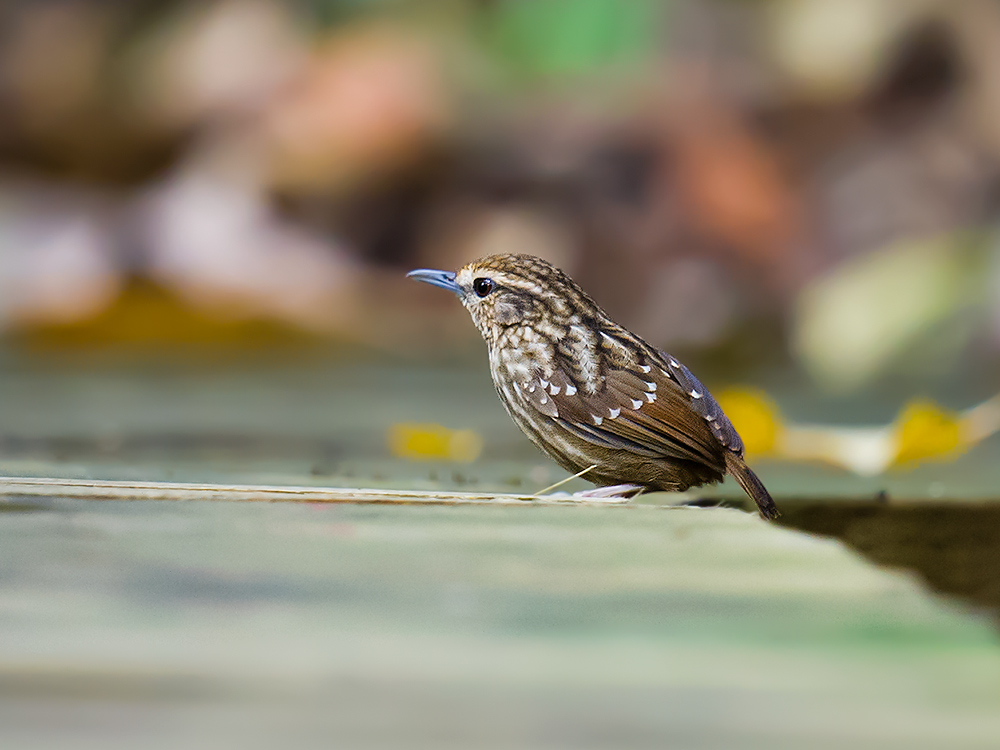
Sat. 19 Jan.
Jiānfēnglǐng
Walking alone on the loop trail at first light, I heard a wing beating the air. The sound came from a small bird on the ground. I strained to find the bird. Finally I discerned an Eyebrowed Wren-Babbler Napothera epilepidota hainana (endemic ssp.). The bird was only 3 m from me. This tiny brown bird is a master skulker; it almost never leaves the forest floor. If a breeze is blowing, then it is difficult to know whether the wind just twitched that fallen leaf, or whether the wren-babbler moved it while foraging. I photographed this species in Xishuāngbǎnnà in Yunnan last year, and I therefore spared myself the exertion of photographing it again. I found yet another Red-headed Trogon near the giant tree. Another bird wave near the Míngfèng Gǔ Rock afforded me views of a pair of Grey-chinned Minivet, Hainan Leaf Warbler, Black-winged Cuckooshrike Coracina melaschistos saturata, and Yellow-browed Warbler. Grey-capped Pygmy Woodpecker was high in a tree. At Kōngzhōng Huāyuán, I got a fleeting glimpse of a male Hainan Blue Flycatcher Cyornis hainanus. A Chinese Barbet was there, as were the bulbuls and Grey-chinned Minivet. I had lunch at the little restaurant by Lake Tiānchí. In the lake was a single Little Grebe Tachybaptus ruficollis poggei. Along the shore was Amur Wagtail Motacilla alba leucopsis, ssp. of White Wagtail. After lunch, I was by the research station talking to some of the researchers. As we chatted, a noisy flock of Sultan Tit flew in. I spotted a pair of Hainan Laughingthrush Dryonastes [chinensis] monachus (endemic ssp. of Black-throated Laughingthrush). There were also a Long-tailed Shrike and a pair of Light-vented Bulbul Pycnonotus sinensis hainanus. I saw White-rumped Munia Lonchura striata swinhoei.
Sun. 20 Jan.
Jiānfēnglǐng
In the morning, in the parking lot of the resort I found a male Scarlet Minivet Pericrocotus speciosus fraterculus. At Lake Tiānchí I was able to get good photos of Hainan Laughingthrush. I drove to the old “botanical garden” and found Puff-throated Bulbul. I returned to Lake Tiānchí, where I found Little Grebe, Amur Wagtail, Light-vented Bulbul, White-rumped Munia, Chinese Pond Heron Ardeola bacchus, and a female Siberian or Stejneger’s Stonechat (Saxicola maurus przewalskii or S. [maurus] stejnegeri).
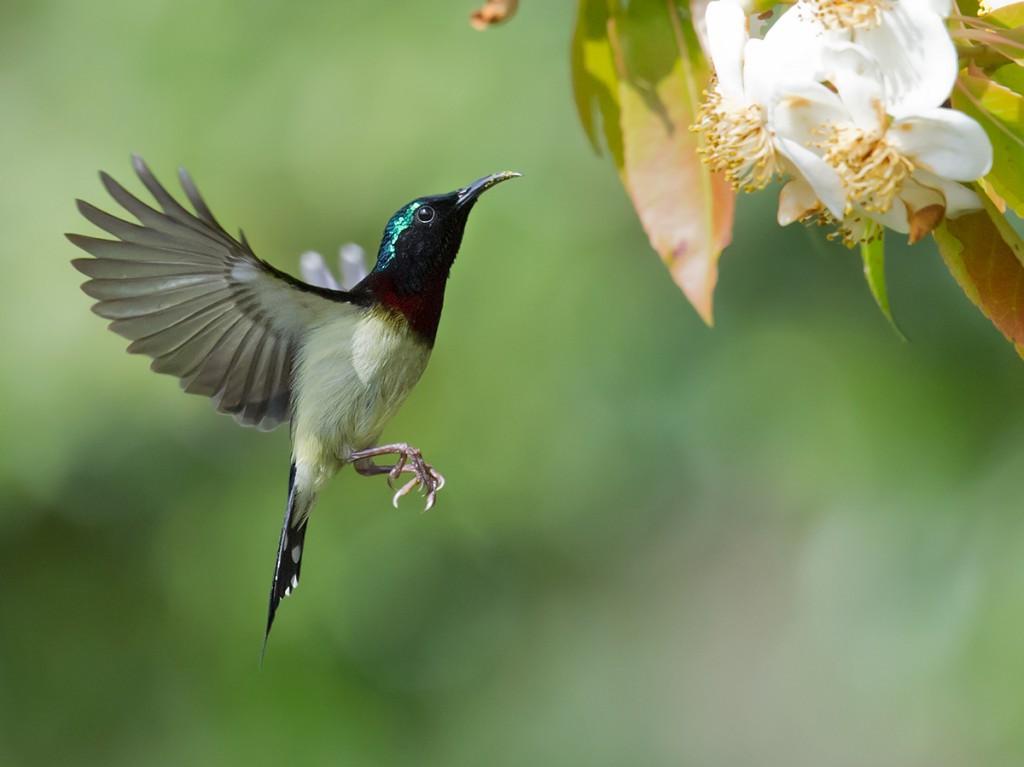
Mon. 21 Jan.
Jiānfēnglǐng
At dawn I drove down to Lake Tiānchí. I wanted another look at Hainan Laughingthrush. I didn’t see them this time. The stonechat was still there, as were a pair of Streak-breasted Scimitar Babbler. I photographed Plain Prinia Prinia inornata extensicauda. I returned to the resort. Tiānjīn Māma pointed to a female Red-headed Trogon in a nearby tree. A male was nearby. I found Hainan Leaf Warbler, finally getting a satisfactory image of that species. I met Mrs. Huáng, a budding bird photographer from Beijing. Mrs. Huáng and I photographed a male Fork-tailed Sunbird Aethopyga christinae christinae (endemic ssp.). We walked the boardwalk trail to Kōngzhōng Huāyuán, where we saw the Chinese Barbet and the three species of bulbul, once again feeding on the abundant fruit. Somewhere in the trees above, Pale Blue Flycatcher was singing. I couldn’t see the Pale Blue, but I ID’d it by comparing the song I was hearing to the almost identical song I had downloaded from Xeno-Canto and synced over to my iPhone 3GS. After lunch with Mrs. Huáng and her sister, I was walking back to my room. Suddenly I was in the middle of a mixed flock. The biggest ingredient was Huet’s Fulvetta Alcippe hueti rufescentior (endemic ssp.). There were also Puff-throated Bulbul, a pair of male Sultan Tit, and Yellow-billed Nuthatch. An Olive-backed Pipit jumped onto one of the posts holding up the clotheslines.
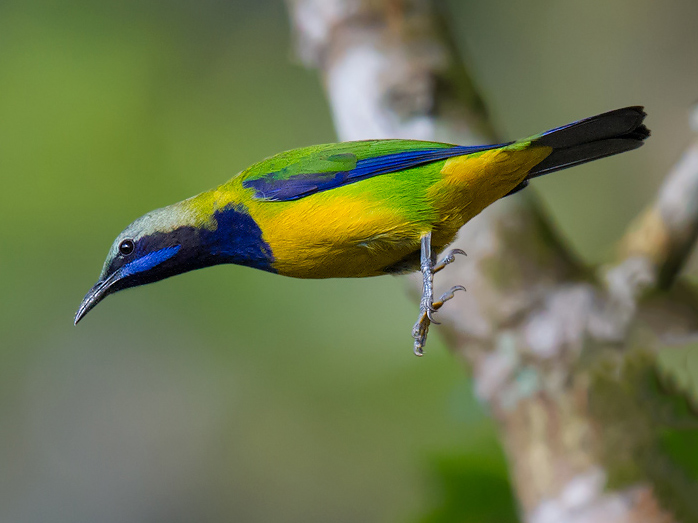
Tues. 22 Jan.
Jiānfēnglǐng
At the resort, I climbed onto the rooftop of the employees’ dormitory next to a flowering tree; this spot became so productive that I named it the Magic Rooftop. There I met a pair of Orange-bellied Leafbird Chloropsis hardwickii lazulina (endemic ssp.). Chinese Barbet and Mountain Bulbul joined them. White-bellied Erpornis showed up, along with a pair of Grey-chinned Minivet. The minivets were building a nest in the upper branches of the flowering tree. Scarlet Minivet were sticking to the higher parts of the taller trees. A Grey-capped Pygmy Woodpecker was atop one of the tall trees. The chirring of Red-headed Trogon was audible from the rooftop. When the sun became too bright, I moved to the picnic table in front of my room. I heard the sweet, cheerful song of Pale Blue Flycatcher. I knew the bird was somewhere near, but where? I spotted the bird on a low bough of a tree. The song of the flycatcher moved me. He was singing beautifully, softly. The flycatcher was barely opening his bill, and still the music came out. The song welled up from deep inside him. It is an inseparable part of him, something he very much believes in . . . I was brunching in the chalet area, admiring the flycatcher and eating at the same time. I was sitting at a little picnic table. I had a front-row seat to Paradise. In Heaven, the weather will be something like Jiānfēnglǐng in January: cool nights, warm days, morning dew, no rain.
Later I walked around the resort and saw Fork-tailed Sunbird and Streak-breasted Scimitar Babbler.
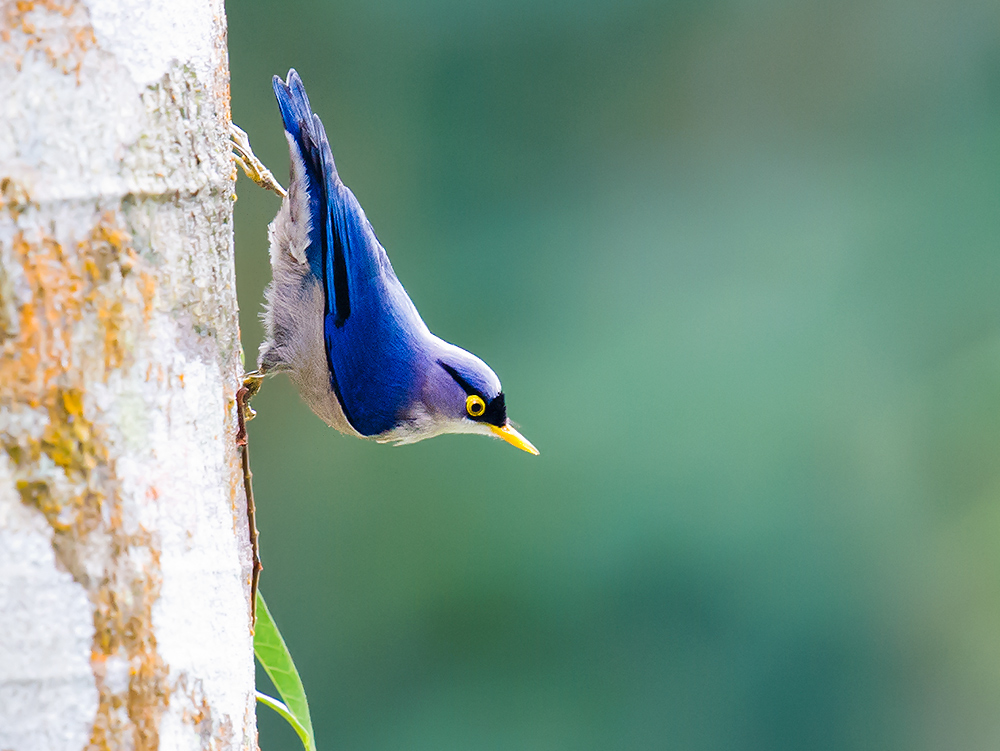
Wed. 23 Jan.
Jiānfēnglǐng, Bàwánglǐng (霸王岭)
I was on the Magic Rooftop at first light. Orange-bellied Leafbird were feeding along with Mountain Bulbul. Yellow-billed Nuthatch flew to a bare tree. I had first views in Hainan of Bronzed Drongo Dicrurus aeneus aeneus, Japanese White-eye Zosterops japonicus hainanus (endemic ssp.), and Verditer Flycatcher Eumyias thalassinus thalassinus, and my first look ever at Mountain Imperial Pigeon Ducula badia griseicapilla. After nine nights at Jiānfēnglǐng, I headed to Bàwánglǐng (霸王岭).
Thurs. 24 Jan.
Bàwánglǐng
At the hotel in Bàwánglǐng Town, I had my first look ever at Ashy Woodswallow Artamus fuscus. Driving up to Bàwánglǐng National Forest Park, I saw Bronzed Drongo. Around the “haunted house” (an abandoned building near Kilometer 23), I saw a flock of perhaps 20 Light-vented Bulbul, Mountain Bulbul, and Puff-throated Bulbul, a Green-billed Malkoha, White-throated Fantail, Huet’s Fulvetta, Olive-backed Pipit, and Grey Wagtail. My assistant and I took a walk up the road. We found 2 Grey-chinned Minivet and a mixed flock containing Huet’s Fulvetta, White-throated Fantail, and Rufous-faced Warbler Abroscopus albogularis fulvifacies. Back at the haunted house, I found another big flock of Huet’s Fulvetta, Yellow-browed Warbler, Fork-tailed Sunbird, and 2 Black Bulbul Hypsipetes leucocephalus perniger (endemic ssp.). Bàwánglǐng is a good preserve, but access to the topmost area is restricted; I was allowed to go to the area around the haunted house today only; afterward, the manager said, I would need a permit from the authorities in Hǎikǒu.
Fri. 25 Jan.
Bàwánglǐng
Food poisoning. No birding.
Sat. 26 Jan.
Bàwánglǐng
I was still weak but managed to bird for a few hours. On the road heading up the mountain at Bàwánglǐng, at about 1000 m above sea level, I saw two raptors: perching Crested Goshawk Accipiter trivirgatus indicus and soaring Crested Honey Buzzard Pernis ptilorhynchus orientalis. I saw both birds on the main road leading into Bàwánglǐng. Near Bàwánglǐng Town, I found Spotted Dove Spilopelia chinensis chinensis. Other birds: Huet’s Fulvetta, Chestnut Bulbul, and White-throated Fantail.
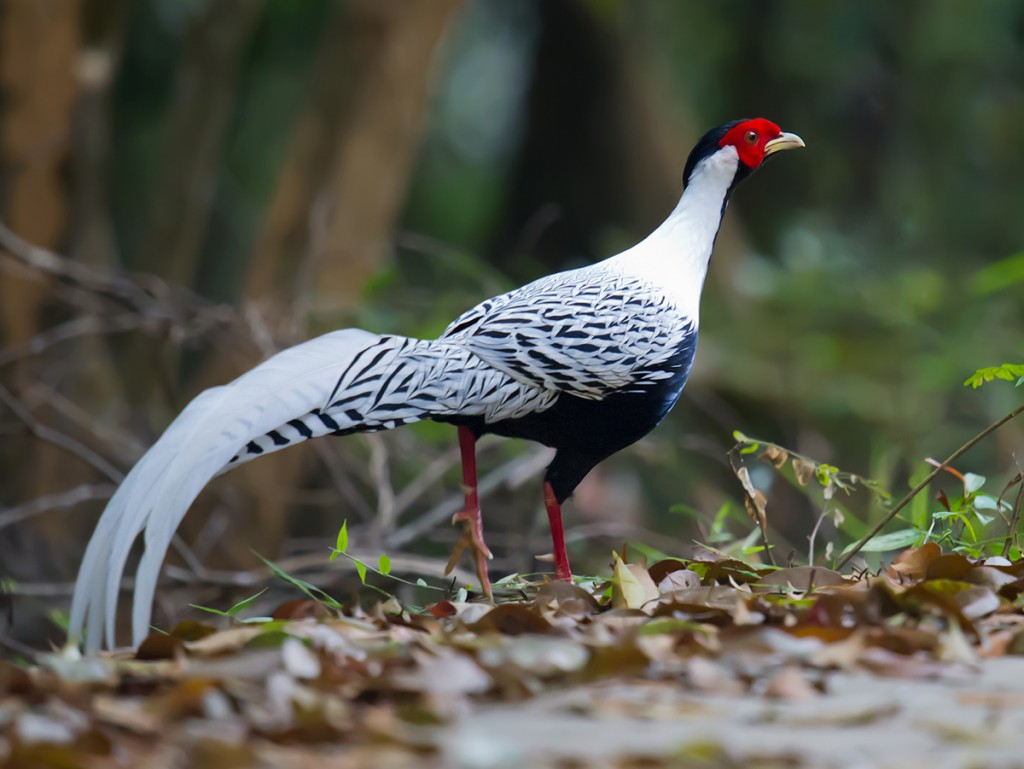
Sun. 27 Jan.
Bàwánglǐng
Today was Hainan Silver Pheasant day. We saw our first pair by Dong Yi. At dusk we saw another. The view at dusk came about this way: As the afternoon light began to fade, I said to my assistant, “Let’s not quit just yet. Let’s drive up the mountain a ways. Maybe a Silver Pheasant will cross the road.” We drove up the hill. Five minutes later, a Silver Pheasant crossed the road. Also by Dong Yi, we found a flock of Large Woodshrike Tephrodornis virgatus hainanus. Woodshrikes resemble shrikes but are not closely related to them; they are easily distinguished from shrikes by their flocking behavior and preference for forests.
Mon. 28 Jan.
Bàwánglǐng, Hǎiwěi (海尾)
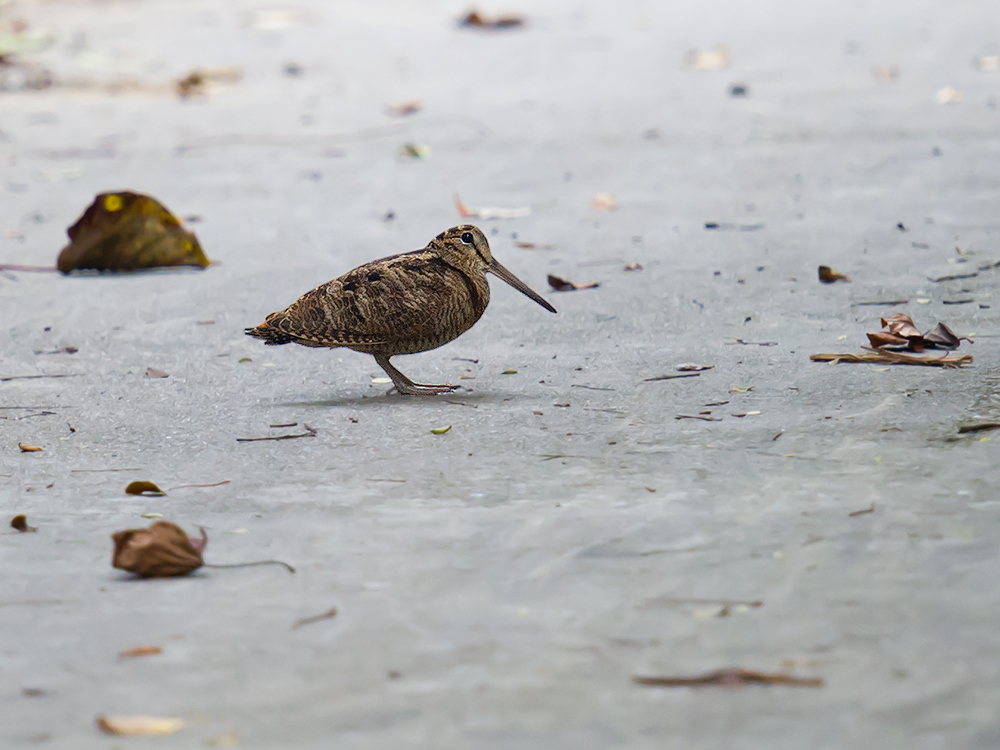
Early this morning at Bàwánglǐng, I once again found Hainan Silver Pheasant along the side of the road. This time, there were four: three males and a female. The female and two of the males flew across the road. The third male stayed on the ground long enough to allow a photo. I had about four seconds to record an image. In that time, I had to stop the car, reach over to the foot of the passenger seat for my camera, stick it through my open window, set it on the rear-view mirror, and shoot. One mistake and the bird would have gotten away. What a thrill it was to get the process right and come home with a winner. Further uphill I saw, feeding on the road, a Common Emerald Dove Chalcophaps indica indica. Also saw mixed flock containing Huet’s Fulvetta and White-bellied Erpornis. On the road leading to Dong Yi, I found Eurasian Woodcock Scolopax rusticola. The woodcock was sitting motionless on the pavement. It looked like any of the large leaves lying here and there on the road; the difference was that this leaf had a long bill. At the large cleared-out area around Dong Yi, I had male and female Oriental Magpie-Robin, Olive-backed Pipit, Grey Wagtail, Siberian or Stejneger’s Stonechat, Long-tailed Shrike, and Cinereous Tit Parus cinereus hainanus (endemic ssp.). Driving slowly on the forest road, we found Streak-breasted Scimitar Babbler. We left Bàwánglǐng and drove to the coast. Our destination: Chāngjiāng Xiàn Hǎiwěi Shīdì Gōngyuán (昌江县海尾湿地公园). English: Hǎiwěi Wetland. I was looking for Grey-headed Swamphen Porphyrio poliocephalus poliocephalus and Lesser Whistling Duck Dendrocygna javanica. I found both species inside the park. Before entering the park, I photographed Black Drongo Dicrurus macrocercus cathoecus, Eastern Cattle Egret Bulbulcus coromandus, Common Kestrel Falco tinnunculus interstinctus, and Shikra Accipiter badius poliopsis. Inside: Little Grebe, Spotted Dove, Cinereous Tit, Light-vented Bulbul, Common Moorhen Gallinula chloropus chloropus, Grey Heron Ardea cinerea, Little Egret Egretta garzetta garzetta, Great Egret Ardea alba, Black-crowned Night Heron Nycticorax nycticorax nycticorax, Black-capped Kingfisher Halcyon pileata, Pied Kingfisher Ceryle rudis insignis, White-throated Kingfisher Halcyon smyrnensis fokiensis, and Olive-backed Sunbird Cinnyris jugularis rhizophorae.
Tues. 29 Jan.
Hǎiwěi, Qióngzhōng (琼中)
Still at Hǎiwěi Wetland. New Hǎiwěi species: Siberian/Stejneger’s Stonechat, Plain Prinia, Eastern Marsh Harrier Circus spilonotus, Pheasant-tailed Jacana Hydrophasianus chirurgus, Purple Heron Ardea purpurea manilensis, and Richard’s Pipit Anthus richardi.
Wed. 30 Jan.
Qióngzhōng
Spent day resting at Qióngzhōng (琼中). No birding.
Thu. 31 Jan.
Wǔzhǐshān (五指山)
At Ātuólǐng (阿陀岭) I photographed Rufous-capped Babbler Cyanoderma ruficeps goodsoni (endemic ssp.). Also got a nice shot of Hainan Leaf Warbler, and I found Huet’s Fulvetta. I’m near Mt. Five Fingers (五指山, wǔzhǐshān). Elev. at Ātuólǐng: about 925 m (3,040 ft.).
Fri. 1 Feb.
Wǔzhǐshān, Jiānfēnglǐng
On the road leading up to the television tower at Ātuólǐng, I photographed male White-throated Rock Thrush Monticola gularis and Pallas’s Leaf Warbler Phylloscopus proregulus. Other birds: Common Emerald Dove, Chinese Barbet, Black Bulbul, White-bellied Erpornis, Huet’s Fulvetta, Rufous-capped Babbler, and White-crowned Forktail. On the road to Máoyáng (毛阳), I snapped a photo of a male Red-bellied Rock Thrush Monticola solitarius philippensis, ssp. of Blue Rock Thrush. Grey Wagtail were numerous along the side of the road. Oriental Magpie-Robin were common near villages. After a long drive, I arrived back at Jiānfēnglǐng.
Sat. 2 Feb.
Jiānfēnglǐng
Once again heard, but still have yet to see, Hainan Partridge. Morning on Magic Rooftop: Chinese Barbet, Greater Racket-tailed Drongo flying gracefully by, Scarlet Minivet, Verditer Flycatcher, Sultan Tit, Yellow-billed Nuthatch, Hainan Leaf Warbler, Grey-chinned Minivet, Japanese White-eye, Red-headed Trogon, White-bellied Erpornis, ever-present White-crowned Forktail, Mountain Bulbul, Puff-throated Bulbul, and Fire-breasted Flowerpecker Dicaeum ignipectus ignipectus. The Mountain Bulbul are no longer interested in the flowers on the tree next to the Magic Rooftop.
Sun. 3 Feb.
Jiānfēnglǐng
At long last, I have bagged Spot-necked Babbler, yet another subspecies endemic to Hainan. Yesterday afternoon, I took a long, slow drive up the hill, putt-putting in my Nissan, half-looking for pheasants, half-looking for babblers. Then, I heard calls that sounded like fulvettas’, but weren’t quite the same. My Swarovski 8 x 32 binoculars pulled in the image from the dim forest: Spot-necked! A long wait last night produced no images but confirmed that I’d found the place. Then the early run this morning; I saw the Spot-necked within a minute of arriving at the spot. They darted into the gloom, but I was confident that they’d be back. Sure enough, they were back, and I got my first set. Mediocre shots; I wanted more. Another disappearance, another long wait, and then, once again, paydirt. I hung in and fought the battle. I stood in the leech-infested forest; I held out for Spot-necked Babbler. I was totally focused. Highwaymen, grim Hainan mountain highwaymen, could come to rob me, and I’d say, “Hold on, please; I’m in the middle of shooting the Hainanese subspecies of Spot-necked Babbler.” “Oh, well, in that case … ” they’d say. In the afternoon I went back to the spot and got best-evers of that species. Some of my shots were taken at ISO 12800, and they turned out good. Just before shooting Spot-necked Babbler, I got my first-ever views and images of Dusky Fulvetta Alcippe brunnea arguta (endemic ssp.).
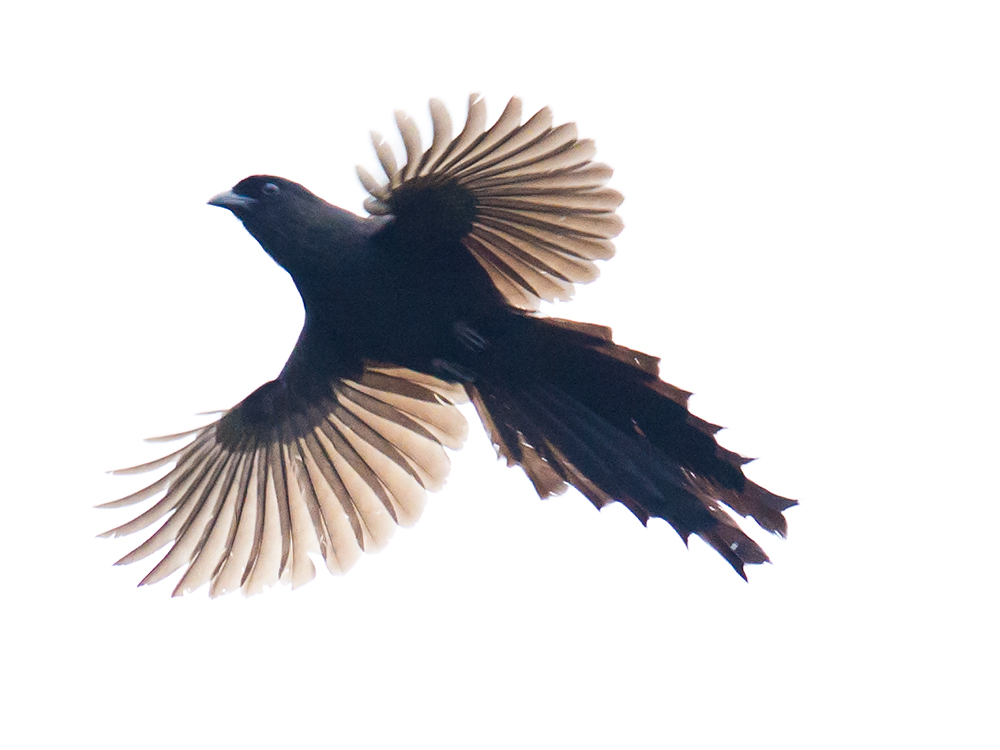
Mon. 4 Feb.
Jiānfēnglǐng
Finally, finally, finally! I’ve photographed Ratchet-tailed Treepie Temnurus temnurus. I was on the Magic Rooftop. A pair passed through quickly, using only the crowns of the trees. Within minutes they were gone. Leaving the Magic Rooftop, I found a male Red-headed Trogon on the wall separating the resort from the military property next door. In the afternoon, on another rooftop (that of the highest building at the resort), I heard Collared Owlet. Other birds: Sultan Tit, White-bellied Erpornis, and Grey-chinned Minivet and Scarlet Minivet. I got my best-ever images of Pale Blue Flycatcher. Spot-necked Babbler made their characteristic calls, then, just as it was getting dark, very fleetingly appeared. I got full-body images of Hainan Laughingthrush.
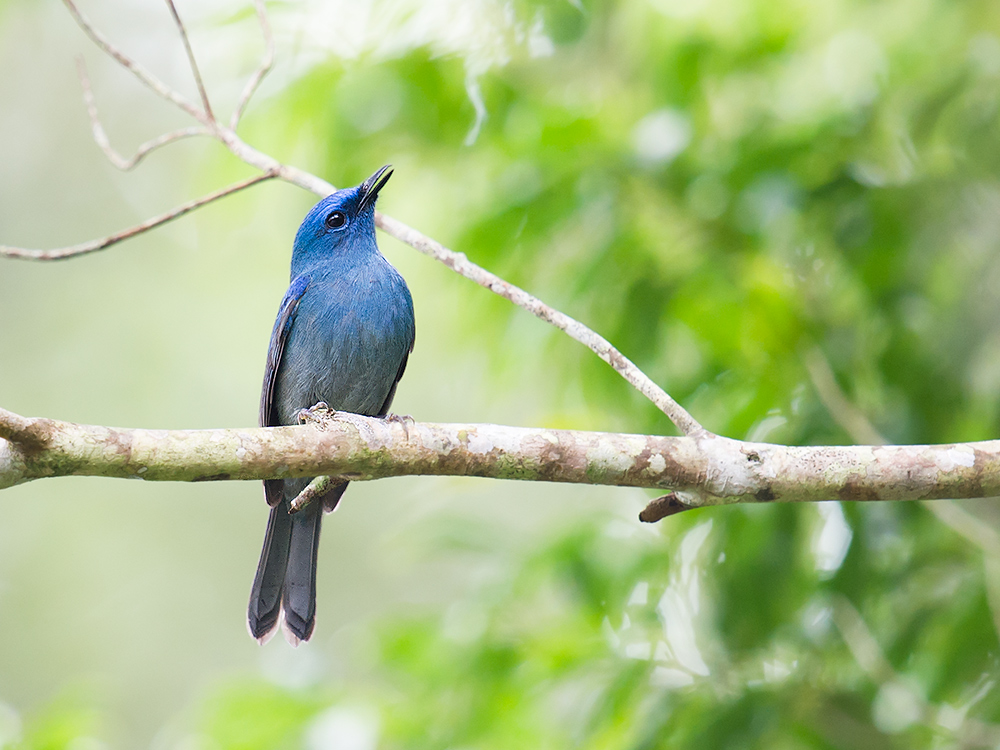
Tues. 5 Feb.
Jiānfēnglǐng
Although I saw no new species today, it was an exciting day photographically; I achieved memorable shots of a male Hainan Blue Flycatcher and a female Fork-tailed Sunbird. I got those images in the garden of a hotel near Lake Tiānchí. In the morning, I was on the Magic Rooftop at the resort. Birds were plentiful. The most interesting bird was Rufous-faced Warbler, which I recorded for the first time at Jiānfēnglǐng.
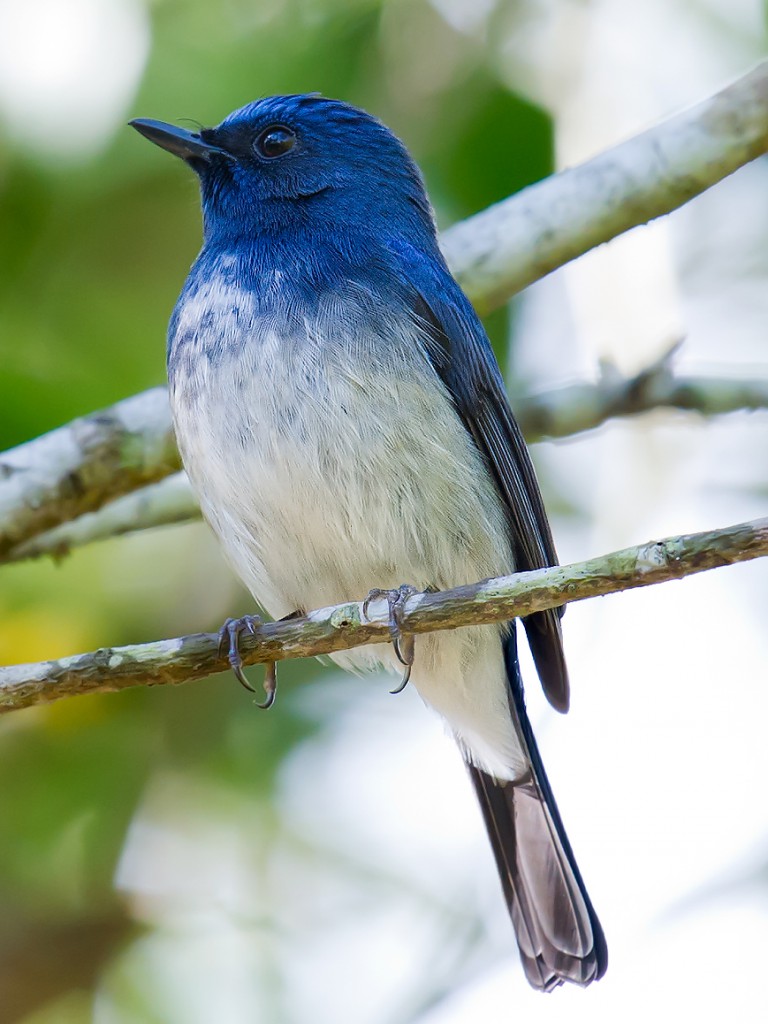
Wed. 6 Feb.
Jiānfēnglǐng
At long last, I’ve seen Hainan Peacock-Pheasant Polyplectron bicalcaratum (endemic sp.). I was on the boardwalk trail at the resort. At about 08:30 I came upon the bird. It was a female, apparently alone. I noted its smallness (it’s noticeably smaller than female Silver Pheasant) and the lack of bare red facial skin. I observed its long tail. There was no chance for a photograph. The peacock-pheasant slipped into the undergrowth. Soon after, tourists started arriving. Huet’s Fulvetta were near the spot where I saw the peacock-pheasant. A pair of Streak-breasted Scimitar Babbler have made a nest. Later in the morning, there arrived a very loud mixed flock containing three Greater Racket-tailed Drongo, 2 Ratchet-tailed Treepie, and a flock of 5 Lesser Necklaced Laughingthrush Garrulax monileger schmackeri. I photographed Lesser Yellownape Picus chlorolophus longipennis (endemic ssp.). In the afternoon around Lake Tiānchí, I saw a single Chinese Blackbird Turdus mandarinus. The female Fork-tailed Sunbird was still there, as was the male Hainan Blue Flycatcher. I saw Japanese White-eye and Chestnut Bulbul.
Thu. 7 Feb.
Jiānfēnglǐng
I spent the morning in the forest around the resort. I watched the nesting scimitar babblers again and saw Red-headed Trogon and Dusky Fulvetta. Later, a large mixed flock arrived. In it were 2 Ratchet-tailed Treepie, 3 Greater Racket-tailed Drongo, 7 Large Woodshrike, 3 Sultan Tit, a pair of Grey-chinned Minivet, and 3 Rufous-cheeked Laughingthrush Garrulax castanotis castanotis (endemic ssp.). I was able only to get a blurry image of rufous-cheeked, a disappointment. Still, it is a useful record shot; the orange patch is discernible.
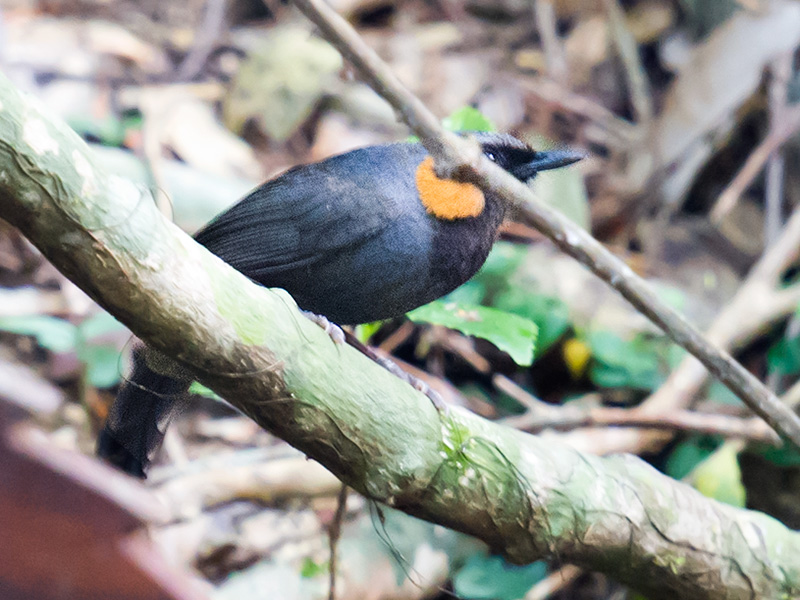
Fri. 8 Feb.
Jiānfēnglǐng
I once again was in the forest at first light. A Collared Owlet was hooting and Hainan Partridge were calling. I found 2 Puff-throated Bulbul and got a best-ever photo of Spot-necked Babbler. Streak-breasted Scimitar Babbler were once again conspicuous. A single male Fork-tailed Sunbird was using a flowering tree in the forest. I saw a Ratchet-tailed Treepie. In the afternoon, I hardly needed to walk at all: just outside my room I found Greater Racket-tailed Drongo, Yellow-billed Nuthatch, and Red-headed Trogon. Because Hainan is in the northern tropics, there is some approximation of seasons; it’s now “springtime” down here, and birds are beginning to want to mate. In recent days I have seen Yellow-billed Nuthatch constructing a nest, I have seen Streak-breasted Scimitar Babbler at their nest, and I have heard Pale Blue Flycatcher singing throughout the day (and especially at sunrise and sunset). Today I was thrilled to see Asian Palm Swift making nests in the thatched roof of the open-air restaurant at the resort. These birds fly into the restaurant at blinding speed then with incredible precision disappear into the roof. The roof is thatched with palm fronds, just the material these swifts need for nesting.
Sat. 9 Feb.
Jiānfēnglǐng
Today is Chúxī, Chinese New Year’s Eve. This is my last full day on Hainan. The weather has been nearly perfect; I’ve lost not a single hour to rain. Along the coast and at the lower elevations, the weather was too warm for me, but at the higher elevations such as Jiānfēnglǐng, the weather has been fine. Yes, it is tough photographing birds in a rain forest. Dim light, birds hidden in the thick vegetation, birds lost in the high canopy: I’ve long since accepted the limitations. Every day involves hours of fruitless searching and waiting. But every day I manage to come up with one, two, or more compelling images. As Steve Bale put it in a text message to me, “[T]he difficulty [of birding in a rain forest] makes the reward that much sweeter when it eventually arrives.”
Today, once again, I was in the forest at first light. Almost immediately, a flock of Rufous-cheeked Laughingthrush flew through. Later on, I found, high in the canopy, a single Common Green Magpie Cissa chinensis chinensis. I saw Green-billed Malkoha and once again a Ratchet-tailed Treepie. I got my best-ever shot of Eyebrowed Wren-Babbler. The wren-babbler jumped onto the edge of the boardwalk, a most impressive sight, as it’s rare to see these birds clear of leaves and twigs. Two were together, and earlier today I’d seen other eyebroweds singing. Chinese Barbet and Spot-necked Babbler were noisy but remained unseen. I saw Huet’s Fulvetta and Eastern Crowned Warbler Phylloscopus coronatus. Why Eastern Crowned? No other Phylloscopus warbler has my bird’s combination of single wingbar (faint here), elongate shape, long bill, long supercilium (almost meeting on nape), and yellowish undertail coverts. I know that in MacKinnon as well as the Handbook to the Birds of the World Eastern Crowned Warbler is not listed as occurring on Hainan. But note that a few days before I took this photo, a Chinese birding friend of mine got clear images of White’s Thrush Zoothera aurea near Míngfèng Gǔ Rock on the boardwalk trail. I looked in MacKinnon; no White’s on Hainan. I looked in Handbook to the Birds of the World; no White’s on Hainan. Clearly, the books can be wrong.
Sun. 10 Feb.
Jiānfēnglǐng, Sānyà, Shanghai
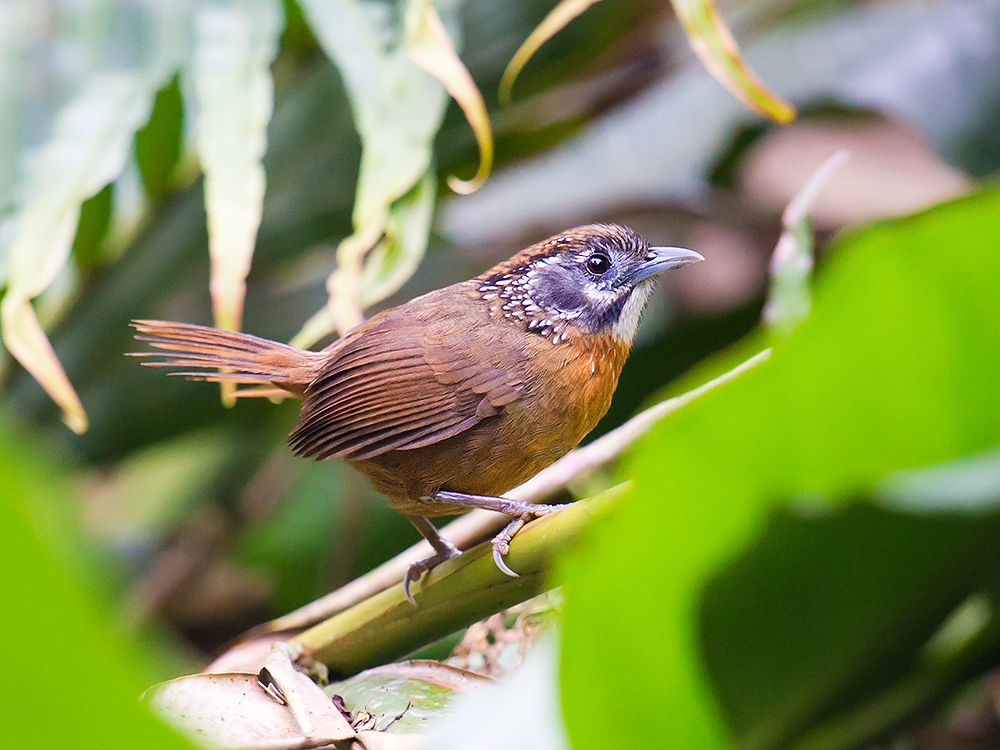
Heard the calls of Spot-necked Babbler: first, the clear, three-note whistle, then the whinnying call. A Spot-necked appeared, making a third sound, a snort. Saw Dusky Fulvetta. Left forest and walked the grounds of the resort. Quiet. I made a final climb up to the Magic Rooftop and saw no new species. A small mixed flock flew into the trees; the Rufous-faced Warbler were agitated, singing constantly, and I saw White-bellied Erpornis. The flowers of the tree beside the rooftop were no longer attractive to Orange-bellied Leafbird. Mrs. Shàng and I drove to Sānyà Airport. Our plane was delayed for more than three hours because of Spring Festival traffic. I arrived in Shanghai in the wee hours of Monday morning.
Equipment
Camera: Nikon D3S
Lens: Nikon VR 600mm F/4G
Binoculars: Swarovski EL 8 x 32
In my backpack: Birds of Southeast Asia, by Craig Robson. In my hotel room: A Field Guide to the Birds of China, by John MacKinnon and Karen Phillipps
MORE ON HAINAN AND SOUTHEAST CHINA
shanghaibirding.com is an authority on birding China’s southeast. Use these resources:
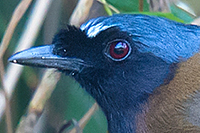
Update on Jianfengling, Hainan, China’s Ideal Winter Birding Spot: Jianfengling is an ideal winter birding spot, writes contributor Mark Havenhand. It is easy to get to, has hotels that accept foreigners, grants freedom to roam, and offers plenty of endemic species and subspecies and wintering birds. I had Hainan Laughingthrush and Rufous-cheeked Laughingthrush, and the tropical mountain forests held Green-billed Malkoha and Eyebrowed Wren-Babbler.
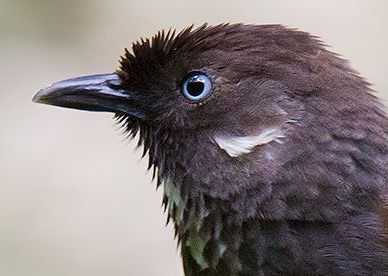
Nonggang Babbler and White-winged Magpie in Guangxi: In the picturesque karst-country village of Longheng, Guangxi, birders note Nonggang Babbler, tick White-winged Magpie, and discover south China favorites Red-headed Trogon and Long-tailed Broadbill.
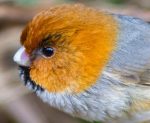 Tianmu Mountains, Zhejiang, Home of Short-tailed Parrotbill: The Tianmu Mountains lie 250 km (155 mi.) southwest of Shanghai. There, birders tick Elliot’s Pheasant and Short-tailed Parrotbill. Crested Bunting sings, Chestnut-winged Cuckoo seeks nests to parasitize, and Buffy Laughingthrush finds a home here. Other goodies include Crested Serpent Eagle and Koklass Pheasant.
Tianmu Mountains, Zhejiang, Home of Short-tailed Parrotbill: The Tianmu Mountains lie 250 km (155 mi.) southwest of Shanghai. There, birders tick Elliot’s Pheasant and Short-tailed Parrotbill. Crested Bunting sings, Chestnut-winged Cuckoo seeks nests to parasitize, and Buffy Laughingthrush finds a home here. Other goodies include Crested Serpent Eagle and Koklass Pheasant.
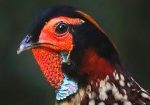 Cabot’s Tragopan & Elliot’s Pheasant at Emeifeng, Fujian: The stars of Emeifeng are gamebirds Cabot’s Tragopan, Elliot’s Pheasant, and White-necklaced Partridge. Birders find as well dozens of south China species such as Blue-throated Bee-eater, Yellow-cheeked Tit, and Grey-sided Scimitar Babbler.
Cabot’s Tragopan & Elliot’s Pheasant at Emeifeng, Fujian: The stars of Emeifeng are gamebirds Cabot’s Tragopan, Elliot’s Pheasant, and White-necklaced Partridge. Birders find as well dozens of south China species such as Blue-throated Bee-eater, Yellow-cheeked Tit, and Grey-sided Scimitar Babbler.
Featured image: Sunset, Jianfengling National Forest Park, Hainan, China. (Craig Brelsford)
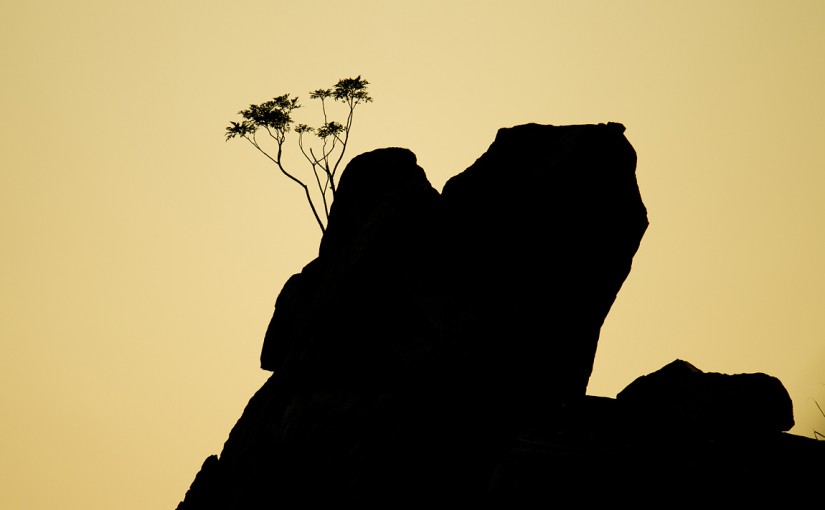

Thank you for all the content on Shanghai Birding – it is a wonderful resource and I really appreciate the personal way you described your trip reports. I am particularly fond of this Hainan trip report as it was one of the first places I visited and I read it several times before I went. I believe I found the flowering tree next to the Magic Rooftop! Jianfengling was a fantastic place to visit.
Nat
Hello, Craig–
Just discovered your amazing birding site. My wife and I are looking forward to visiting her family in Guangdong for a few weeks. We also hope to spend a few days in Hainan, in part inspired by your birding experience in Jianfengling.
However, we’re finding it a challenge to book lodging in that area. I’m not sure what year you were there but wonder if you have some tips for reservations at the place you stayed, or similar.
Thanks for your time. Happy birding and Happy Thanksgiving!
Hi Scott, thank you for using shanghaibirding.com. I am going to alert Mark Havenhand, the author of the latest update (https://www.shanghaibirding.com/hainan-birding/) on Shanghaibirding.com about birding Hainan.
Here is my index page for Hainan:
https://www.shanghaibirding.com/tag/hainan-birding/
Also near Guangdong and interesting is Guangxi:
https://www.shanghaibirding.com/nonggang/
Fujian is also nearby:
https://www.shanghaibirding.com/tag/fujian-birding/
Guangdong and Hong Kong also have great areas. Try that mountain park in Guangzhou just north of the city.
Mark’s update mentions, and my report from nearly 11 yrs ago makes clear, that birding in the mountains of Hainan is delightful in the winter. I mentioned in the report that heaven has weather something like Jianfengling in winter. Birds are amazing, too. Just close your eyes when you’re in the lowlands; the extent of the habitat loss there is heartbreaking.
Best wishes! Thanks again for using the website. Any update you can get on the lodging situation would be welcome.
Hi Scott,
I stayed in a simple hotel about 1km outside the park gate in Jianfengling village – this had a very nice view of gardens for urban birding and was in the village for dinner etc – was also more or less at sea level so quite warm – memory says about 25C. But it meant getting transport up the mountain every day..unless you go during Chinese NEw Year i think you need not book it
Staying in the park in my time was also hard – there is a hotel by the lake which i think does not accept / like foreigners – its middle class Chinese in cars kind of place. The real birders place is near the boardwalk – the rooms are fine but the kitchen is really filthy – but you are ideally placed for early mornings at the boardwalk. Its pretty cold up there and there is nothing else to do…i think room nr 5 was mine with a fantastic terrace, you should ask for the birders room. Suggest to take pot noodles
I would think of 2 nights by the boardwalk and maybe 2 more in the village. The boardwalk hotel only has a few rooms – try to book it – they only speak Chinese both places
Boardwalk is noisy once people arrive say from 8am to 4pm – the wooden steps amplify the noise. Follow my route up the mountain during the day packing a picnic
Good luck
Mark